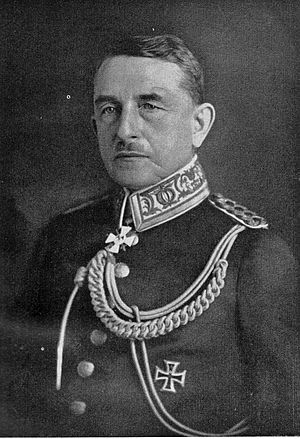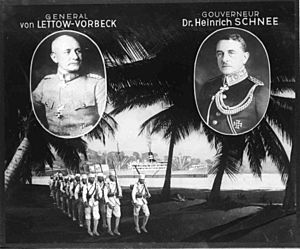Heinrich Schnee facts for kids
Quick facts for kids
Heinrich Albert Schnee
|
|
|---|---|
 |
|
| Governor of German East Africa | |
| In office 1912–1918 |
|
| Preceded by | Albrecht von Rechenberg |
| Succeeded by | Position abolished Treaty of Versailles 1919 Weimar Republic 1933 |
| Personal details | |
| Born | 4 February 1871 Neuhaldensleben,German Empire |
| Died | 23 June 1949 (aged 78) Berlin, West Germany |
| Nationality | German |
| Profession | diplomat, public servant, politician, author |
Heinrich Albert Schnee (born February 4, 1871 – died June 23, 1949) was a German lawyer, government official, and politician. He is best known for being the last Governor of German East Africa, a former German colony. He also wrote books and was involved with different organizations.
Contents
Early Life and Education
Heinrich Schnee was born in Neuhaldensleben, Germany. His father, Hermann Schnee, was a court official. Heinrich went to high school in Nordhausen. He later studied law at universities in Heidelberg, Kiel, and Berlin. He earned his law degree in 1893.
Starting a Career in Government
In 1897, Schnee began working for the German government's Federal Foreign Office. The next year, he became a judge and a deputy governor in German New Guinea. In 1900, he moved to German Samoa to serve as a district officer and deputy governor there.
While in New York in 1901, Schnee married Ada Adeline Woodhill. She was an actress from New Zealand with English and Irish family roots.
After 1904, Schnee returned to Germany. He worked in the Colonial Department of the Foreign Office. He held several important roles, including a colonial advisor in London. By 1911, he was a director in the Imperial Colonial Office in Berlin. He was in charge of political and administrative matters.
Governor of German East Africa
From 1912 to 1918, Heinrich Schnee served as the final Governor of German East Africa. This was a German colony in East Africa. His time as governor was greatly affected by the start of World War I.
As governor, Schnee was the top military commander. However, he soon disagreed with General Paul von Lettow-Vorbeck. Lettow-Vorbeck was the commander of the Schutztruppe (colonial protection force). They had different ideas about how to defend the colony. Lettow-Vorbeck wanted to use guerrilla tactics, which meant small, surprise attacks. He eventually took more control of the military operations.
Besides his official duties, Governor Schnee also had to support his family. His wife, Ada, was from England. It was very hard for her to see her home country and her adopted country fighting each other. She faced many difficulties because of this.
After the war ended, on March 2, 1919, Schnee and Lettow-Vorbeck led the returning soldiers from East Africa. They marched through the Brandenburg Gate in Berlin.
Political Work After the War
After World War I, Schnee became a member of the German parliament, called the Reichstag. He represented the German People's Party. He left this party in 1932. There was even some talk in the newspapers that he might become the Chancellor.
From 1933 to 1945, he was again a member of the Reichstag, this time for the Nazi Party. Schnee was very interested in Germany having colonies outside Europe. However, the new Nazi leaders were not interested in this idea.
Schnee was also known around the world for supporting German colonial interests. He was often invited to give talks in the United States and other European countries. He was also part of the League of Nations' Manchuria Commission. This group worked with China and Japan to try and solve their conflict over Manchuria.
Leading Associations
In 1926, Schnee became the president of the Federation of Germans abroad. He held this position until 1933. From 1930 to 1936, he was the last president of the German Colonial Society (DKG). This group was later replaced by another organization called the Reichskolonialbund.
After the Second World War, the Allies (the countries that fought against Germany) looked into Schnee's past. Because he had been a member of the Nazi Party in the Reichstag, he was not allowed to continue his public work. He died in 1949 in a car accident in Berlin. He was buried in a cemetery near the highway.
How History Views Heinrich Schnee
Heinrich Schnee is a figure connected to how German colonial history is understood. Through his books, essays, political work, and speeches, he tried to make the idea of colonies important to Germany again. He wanted Germany to get back its former colonial territories. However, by 1936, it became clear that his influence was fading. He was not given a role in the new colonial organization and did not join it.
Awards and Special Recognition
- 1925: He received an honorary doctorate degree from the University of Hamburg.
- 1941: He was given the Eagle Shield of the German Reich, a special award.


